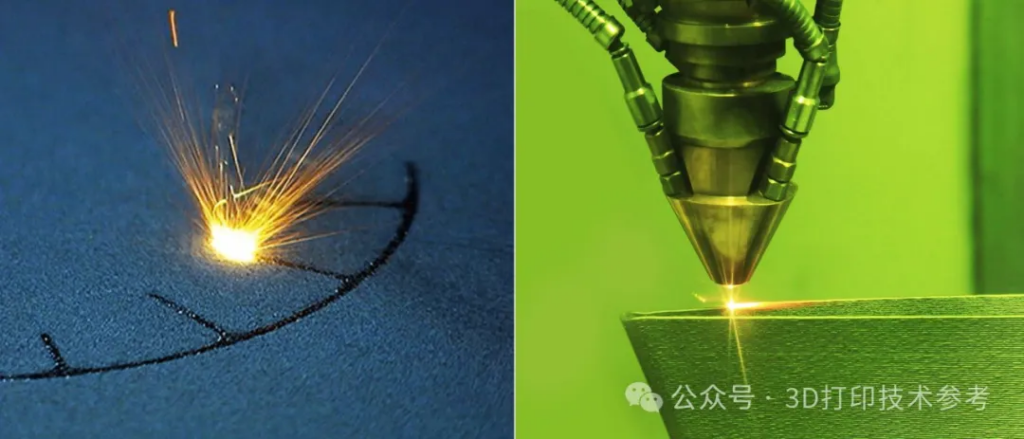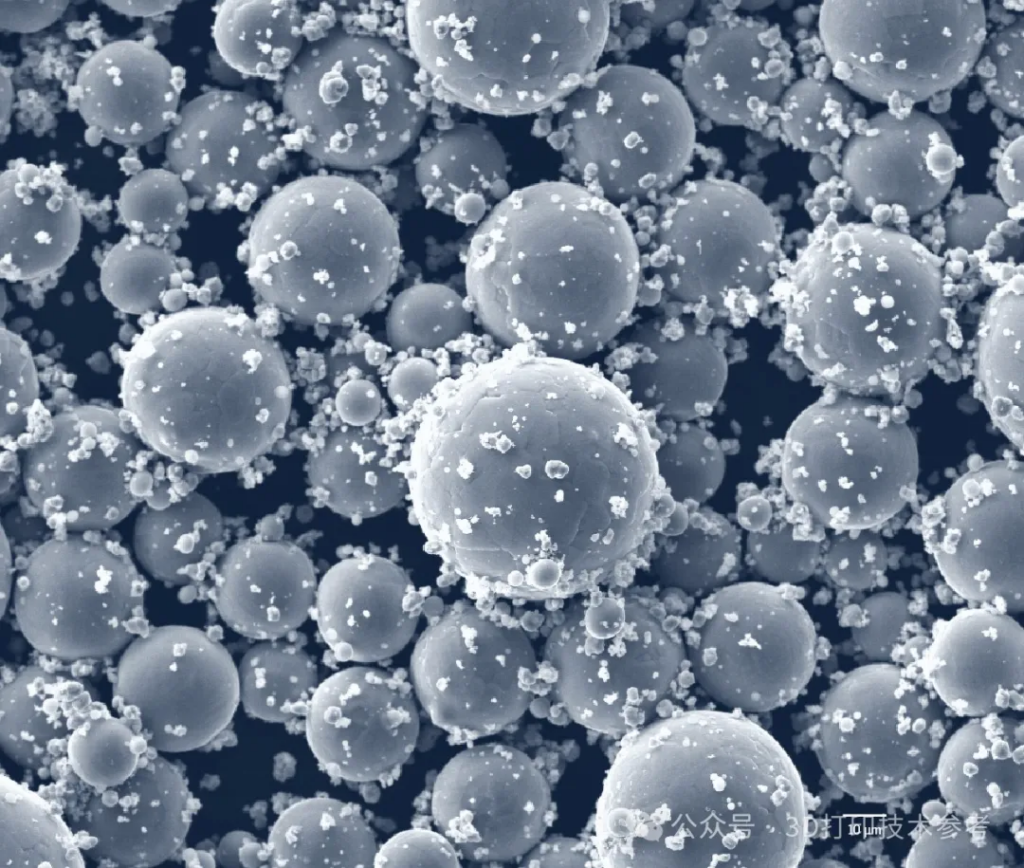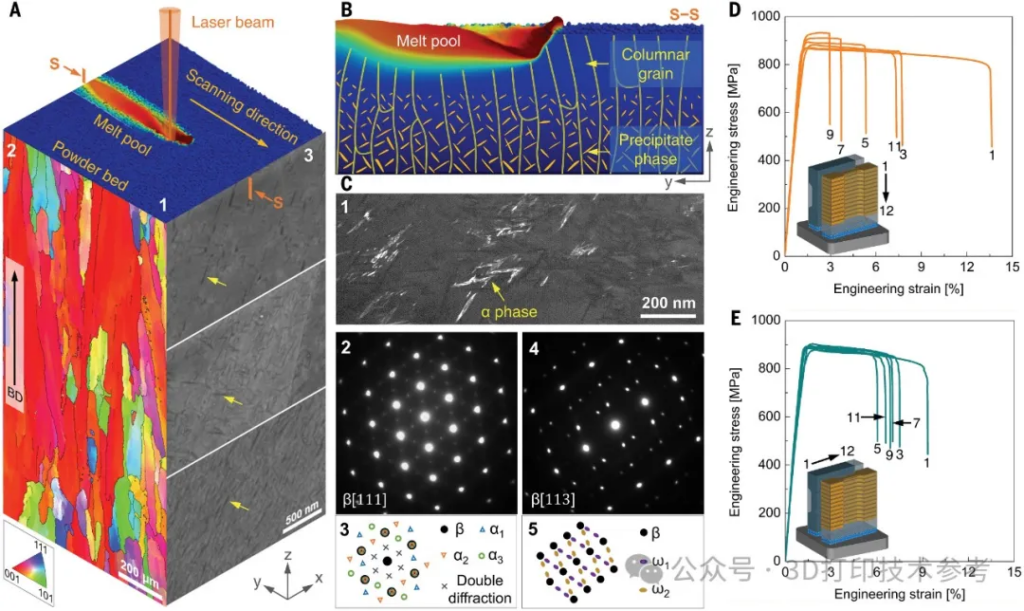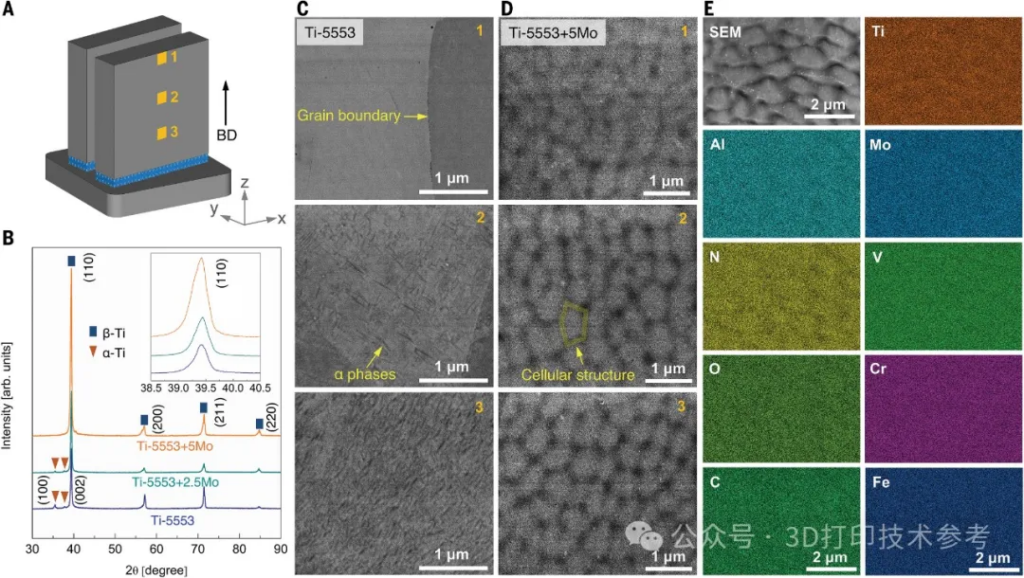The second Science article in the field of 3D printing technology in 2024 was published on February 8th.
come from (a place)University of Queensland, Australia(Jingqi Zhang et al,)Chongqing University(Ziyong Hou, Xiaoxu Huang),Technical University of DenmarkThe joint team published an article titled "Ultrauniform, strong, and ductile 3D-printed titanium alloy through bifunctional alloy design". Ultrauniform, strong, and ductile 3D-printed titanium alloy through bifunctional alloy design".Titanium alloys prepared by 3D printing reach theWith a yield strength of 926 MPa and a ductility of 261 TP3T, a balance of strength and ductility has been achieved.

Background of the studyCoarse columnar grains and inhomogeneously distributed phases often occur during metal 3D printing, resulting in inhomogeneous or even poor mechanical properties. The research involves a design strategy that allows for a direct method of obtaining high strength and consistent properties of titanium alloys by 3D printing. It was shown that the addition of molybdenum (Mo) to the powdered metal mixture enhanced phase stability and improved the uniformity of strength, ductility and tensile properties of the 3D printed alloys.A Science review article in the same issue noted that the methodology is promising for application to other powder mixtures and the ability to customize different alloys with enhanced properties.
The main reason for the non-uniform properties of metal 3D printed alloys are: In a layer-by-layer 3D printing process, typically with 103-108The high cooling rate of K/s creates a significant thermal gradient near the edge and bottom of the melt pool where the metal powder is melted. The thermal gradient induces epitaxial grain growth along the interface between the newly melted material and the solid material below, with the grains growing towards the center of the melt pool. The heating and partial remelting cycles during multilayer printing eventually lead to the formation of large columnar grains and inhomogeneously distributed phases, both of which are undesirable because they can lead to anisotropy and impaired mechanical property degradation.

Strength-ductility of various metallic materials
Titanium alloys are one of the most widely used metal 3D printing materials. In engineering applications at ambient temperatures, suitable titanium alloys typically exhibit a tensile elongation of 10-25%, which reflects good material reliability. While greater elongation (ductility) facilitates easier molding and is preferred in some applications, increased strength in this elongation range is often preferred for withstanding mechanical loads. The balance between strength and ductility has always needed to be considered in both conventional and additive manufacturing techniques for processing metallic materials.
Strategies and Limitations for Improving Strength and Ductility
There are various strategies to improve the strength and ductility of 3D printed alloys. These include optimization of alloy design, process control, fine grain boundary strengthening and grain microstructure modification, but also suppression of unwanted (brittle) phases, introduction of second phases, and post-treatment. Current research to address the problems of columnar crystals and undesirable phases has focused on in-situ doping of elements to modify the microstructure and phase composition. This approach also promotes the formation of isometric crystals, i.e., structures with approximately equal grain sizes along the longitudinal and transverse axes. In situ alloying offers a promising way to overcome the balance between strength and ductility.Especially in 3D printing technologies such as powder bed fusion and directed energy depositionThe

Researchers have explored grain morphology and mechanical properties when adding different elements to 3D printed alloys. For example, doping nanoceramic zirconium hydride particles into unprintable aluminum alloys resulted in printable and crack-free materials with a refined equiaxed grain microstructure and tensile properties comparable to wrought materials. For titanium alloys, however, commercially available grain refiners usually have limited effect on grain structure. The refinement mechanisms of titanium alloys, particularly the columnar to isometric transition during 3D printing solidification, have been extensively studied, but efficiency limitations remain. Attempts to overcome this obstacle include varying processing parameters, high-intensity ultrasonic applications, introduction of desired heterogeneous structures through alloy design, addition of solutes as grain refiners at heterogeneous nucleation sites , and doping of solutes with high supercooling capacity. Elements such as the β-eutectic stabilizer elements Cu, Fe, Cr, Co and Ni, which limit solubility in titanium.
New research leads to major breakthroughsInstead of using β-eutectic stabilizer elements, which can lead to the formation of brittle intermetallic eutectics in titanium alloys, the researchers chose Mo from the β-homocrystalline group [including niobium (Nb), tantalum (Ta) and vanadium (V)] for Ti-5553 (Ti-5Al-5Mo-5V-3Cr). During the in-situ alloying process, molybdenum is precisely transported into the molten pool and acts as a seed nucleus for crystal formation and refinement during the scanning of each layer. the Mo additive promotes the transition from large columnar crystals to a fine, equiaxed, and narrow columnar crystal structure. mo also stabilizes the desired β-phase and inhibits the formation of phase heterogeneity during thermal cycling.

Characterization of Mo-doped Ti-5553 titanium alloy
The researchers compared the yield strength and elongation at break of Ti-5553+5Mo with Ti-5553 (as well as Ti-55531 and Ti-55511) produced in the L-PBF state and under post-print heat treatment. Compared to Ti-5553 and its similar alloys in the fabricated state, Ti-5553+5Mo shows comparable yield strength, but significantly improved ductility. Post-print heat treatment is commonly used to balance the mechanical properties of L-PBF-produced Ti-5553. Although high yield strengths (>1100 MPa) can be achieved under certain heat treatment conditions, the ductility usually deteriorates significantly with elongation at break <10%, which limits the use in safety-critical applications. For example, Ti6Al4V, the so-called workhorse of the titanium industry, has a recommended minimum elongation at break of 101 TP3 T. In contrast, without the need for a downstream heat treatment, directly printed parts of the Ti-5553+5Mo material, L-PBF, exhibit an excellent balance of strength and ductility, which makes them stand out among similar alloys. Ultimately, with this strategy, the researchers fabricatedMaterial with excellent property uniformity, yield strength 926MPa, elongation at break 26%.

Microstructure and mechanical properties of Ti-5553 produced by L-PBF

Mechanical properties of Ti-5553 and Ti-5553+5Mo produced by L-PBF
The mechanical properties of Ti-5553+5Mo were exceptionally homogeneous and improved relative to those of Ti-5553. Micro-focused computed tomography (micro-CT) scanning to assess part quality revealed that both materials exhibit very high densities, with total pore volume fractions of 0.004024% and 0.001589%, respectively. such high densities indicate that porosity is unlikely to result in highly dispersed tensile properties for Ti-5553 and are also consistent with a high degree of consistency in the mechanical properties of Ti-5553+5Mo. +5Mo high consistency of mechanical properties. In order to reveal the effect of Mo addition on the grain structure, the researchers performed electron backscattering diffraction (EBSD) characterization of Ti-5553 and Mo-doped Ti-5553.The microstructure of Ti-5553 consists of relatively large grains along the scanning direction, which exhibit a strong crystal weave. The addition of 5.0 wt% Mo to Ti-5553 leads to significant changes in the grain structure and the associated crystal structure. Many fine equiaxed grains (~20 μm in diameter) are highly visible, forming along the edges of the scanning tracks of Ti-5553+5Mo. In contrast, the microstructure of Ti-5553+5Mo is characterized by fine equiaxed grains and narrow columnar crystals along the tectonic direction. A closer examination of the microstructure reveals a periodic distribution of fine columnar grains. Unlike the highly woven columnar crystals spanning multiple layers in Ti-5553, the length scale of the columnar crystals in Ti-5553+5Mo is determined by the melt pool size, and the crystal weave becomes random and weak .

Microstructure characterization of Ti-5553 and Ti-5553+5Mo

Phase analysis of Ti-5553 and molybdenum-doped Ti-5553

EBSD characterization of fracture specimens made from Ti-55535END
However, the researchers identified undissolved molybdenum particles in the microstructure and their potential impact is unknown. Indeed, the random presence of undissolved particles in in situ alloying strategies raises concerns related to mechanical and corrosion properties. For example, complete melting of in situ alloy-added particles may require higher energy, and overheating may lead to microstructural changes and deterioration of mechanical properties. In addition, dynamic fatigue and corrosion properties caused by undissolved Mo particles are unknown. Although post-print heat treatment can eliminate undissolved particles, it may alter the microstructure, which may affect the mechanical properties.
Overall, the design strategy proposed in this Science study opens up avenues for exploring different metal powder feedstocks, different printable alloy systems, different 3D printing techniques, and advanced multimaterial printing. It also inhibits the formation of columnar grains and prevents undesirable phase inhomogeneities. These problems arise due to different thermal distributions, which are influenced by the printing parameters of each powder. The strategy also overcomes the balance between strength and ductility in the printed state, minimizing the need for post-printing treatments, advantages that will undoubtedly cause a research boom in the field of 3D printing.